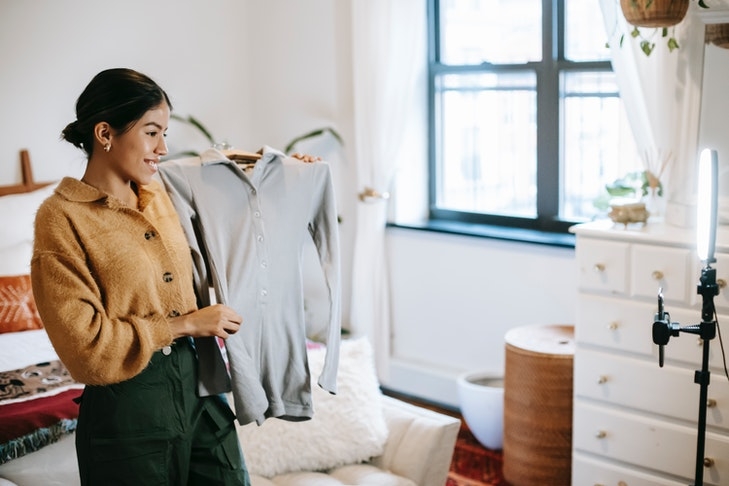Branding and Influencer
9 examples of great influencer fashion marketing campaigns

© Liza Summer / Unsplash
With social media officially one of our go-to methods of communication, the influencer’s social currency has never been stronger. But what is the real impact of influencers on Instagram and elsewhere? Do sponsored posts and tagged stories pay off, or is there a better way to wrangle the power of influencer marketing?
It’s no secret that an endorsement from a Kardashian or another social media celebrity can boost brand recognition dramatically. These people can quickly and directly reach out to their community of fans or point them in your brand’s direction.
It’s even more effective when your product ties in neatly with their niche interests, such as beauty or fitness. However, when it comes to smaller scale influencers, there is often a question of ROI (return on investment).
That’s not to say there haven’t been some incredibly successful influencer-based campaigns. To see the potential behind influencer marketing, let’s take a closer look at nine of the most effective influencer-based fashion campaigns.
Let’s examine nine examples of the most successful influencer-based fashion campaigns to see what all the fuss is about:
Daniel Wellington: Time For A Creative Change

As a company that uses influencer marketing as its only form of marketing, Daniel Wellington is proof that influencers have an impact on sales. As a watch manufacturer, the company has built brand recognition around a fixed hashtag structure and careful selection of influencers.
Regular tags such as #DWPickoftheDay and #DanielWellington are some of Instagram’s most popular fashion-related tags. Using these hashtags as a jumping off point, the company then integrates regular contests and discounts into sponsored posts from influencers.
The result? Engaging and rewarding content that is spread via trusted influencers to loyal audiences.
By ditching other traditional marketing materials, Daniel Wellington presents itself as a community-respected brand that relies on its product to do the talking.
Without glossy photo shoots and overworked campaigns, consumers perceive the brand as a grassroots operation with an authentic feel. Even the influencers that feature the watches in their posts present earthy and genuine imagery, rather than anything too FaceTuned.
Forever 21: A New Perspective

The women’s fashion marketplace is already very crowded, so Forever 21 looked to engage social media audiences with something different than the standard photo shoot. By partnering with established influencers that all had open communication styles with their followers, Forever 21 created a series of game-changing posts.
Rather than showing off their new range in traditional poses, the influencers were instead asked to create content around the process of trying clothes on. Feedback about what fit well and what needed improvement was welcomed and remained unedited.
Through this simple effort to create a genuine look at their upcoming range, Forever 21 was able to not only show off their new range, but also create a relatable, “shopping with friends” atmosphere. The icing on the cake of these videos was when influencers then chose to purchase the outfits they had tried on.
After hearing honest feedback about the pieces that didn’t make the cut, consumers were offered insight into what clothes the influencers really would wear in everyday life.
Zara: Sharing The Reins

On their #iamdenim campaign, high-street retailer Zara selected popular fashion influencers to show off their items in a stylised yet accessible way. One of the most effective ways of doing this was regular “Instagram take-overs” by partnered influencers, like Teesh Rosa.
By letting influencers create raw content around their pieces, Zara was able to convey the message that their real denim was for real, everyday people. Showcasing jeans and denim jackets via reputable influencers yet emphasising the accessibility of prices ensured the campaign’s success.
On the back of this campaign, Zara gained 4.6 million new followers within an eight-month period. That’s some serious ROI!
Lululemon: Exercising Authenticity

Consumers have become quite savvy when it comes to brand authenticity. Despite the plethora of photo editing apps available on social media, audiences still identify with brand messages that seem genuine and focused.
For that reason, Lululemon recognised it needed to change direction and become less aspirational and more accessible.
Over the past two years, the brand’s social media platforms have turned from high-concept photoshoots of their leggings and athletic clothing, and instead now present everyday images of their actual customers.
Whether it’s playing in the snow or resting between yoga sessions, the content is now much more consumer-generated and consumer-focused. Additionally, the influencers chosen to represent the brand are no longer the classic Instagram models.
Instead, the brand has chosen to work with popular wellness and fitness figure –and even an Olympic athlete or two.
With the brand continuing to grow internationally and new physical locations in major cities across the world, this strategy seems to be more effective.
Dr. Martens: Always Fun In-Store

Giving back to the community is something a lot of brands claim to do, but Dr. Marten has gone above and beyond. At their flagship store in Camden, the UK-owned brand has tried to create a different kind of shopping experience for loyal customers.
In store concerts, free haircuts and even tattoo artists on-site to personalise boots are just some aspects of the recent initiative. Where does the wider community follow these events?
Of course, on Dr. Martens’ Instagram, which has now grown to 2.5 million followers as a result of specialised live streams and DIY-sessions content. As chief product officer, Darren Campbell puts it, “Nowadays, commerce is a by-product of engagement.”
Swoon for Monsoon: A Luxury Yet Affordable Vibe

Sites like ManRepeller and NET-A-PORTER are the perfect showcase for high-end labels and influencer relationships. Now, Swoon for Monsoon can be added to this list, proving that this new mix of editorial and e-commerce shouldn’t be limited to luxury brands.
With a site and a digital magazine accessible on both phone and tablet, Swoon for Monsoon is the perfect representation of influencer curated content breathing new life into a fashion brand.
#CastMeMarc: Grassroots Game-Changer

Taking advantage of Instagram’s visual edge, designer Marc Jacobs started the #CastMeMarc campaign to source faces for his upcoming season. As a media presence as well as a fashion designer, this is a great example of an influencer representing their own brand rather than partnering with anyone external.
By simply requiring aspiring models to tag their photos with #CastMeMarc, the campaign spread like wildfire and was successful in finding new faces for the upcoming fashion season.
The other positive outcome was creating a real sense of engagement and agency amongst Marc Jacobs fans. #CastMeMarc was even named as Marketing Week’s campaign of the year.
THINX: Considered Branding

THINX is a company that designs period-proof underwear and has philanthropic roots. The initial steps to found a company came after Miki Agrawal discovered that millions of girls around the world did not have the means to manage their periods.
It makes sense that such a forward thinking, inclusive company then created the slogan “For People With Periods.” By abandoning rigid, binary discussions on who the issue effects, THINX has created a campaign that draws interest from minority interest groups to even large media bodies like Buzzfeed. Another interested party was comedian and influencer Ilana Glazer, who then took part in their follow-up campaign in 2019.
Yeezy: Boosting Reputation

When Kanye West is involved, getting attention for a product shouldn’t be too much of a challenge. However, creating a reputation for a brand before it’s even launched might be.
This is why the Yeezy Boost, the collaboration between Adidas and Kanye West, is such an interesting example of influencer marketing.
A prime goal ahead of the shoe’s release was to ensure people understood its exclusivity. So rather than send boxes and boxes to every relevant influencer, the brand instead carefully selected a restricted amount of people to represent their shoes.
The end result? Success. The waiting lists for the sneakers were endless once consumers understood these weren’t your average Adidas shoes. Additionally, the exclusive, premium reputation of the shoes meant that many of the influencers who were lucky enough to sport them did so without financial compensation.
Fashion Influencers and Marketing: Are They Worth it?
Clearly, there are a number of ways to engage fashion influencers to support your brand. While the standard sponsored posts are always effective, it’s becoming more obvious of their impact as social media marketing grows.
To make a larger imprint, you’ll need to stand out.
Get creative with your influencer selection, your strategy or even, like Yeezy Boost, how you don’t use influencers.
Take inspiration from the successes of these campaigns, and take action!
